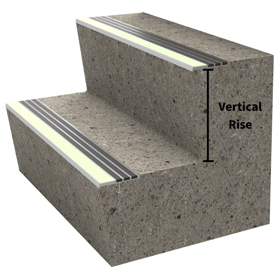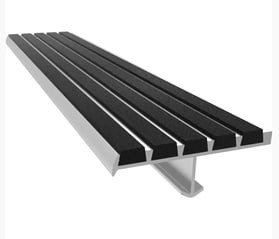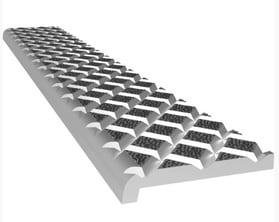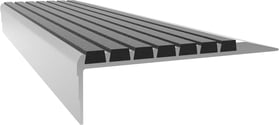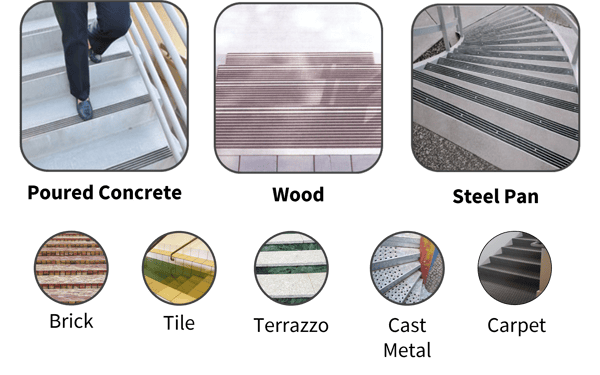In the Details: The Size and Construction of Stair Nosings

The Critical Role of Stair Tread Nosings
Stairs, a fundamental element of architectural design, serve a practical purpose in connecting different levels of a building. While their functionality is evident, the safety and longevity of stairs often lie in the details, such as the size and construction of stair tread nosings. In this blog, we'll delve into the crucial considerations surrounding these elements, shedding light on their significance in both commercial and residential settings.
The Basics of Stair Tread Nosings
Before delving into the size and construction aspects, let's understand stair tread nosings. Stair tread nosings are the horizontal edges of each stair step. They serve several essential  functions:
functions:
Safety:
Nosings provide a slip-resistant surface with a visual indicator of the edge of each step, helping prevent missteps and falls.
Durability
They protect the edge of the stair from wear and tear, ensuring the longevity of the staircase.
Aesthetics
Well-designed nosings can enhance the overall look of the staircase, adding to its visual appeal.
Now, let's explore the size and construction considerations:
Sizing Stair Tread Nosings
The dimensions of stair tread nosings are not arbitrary; they are carefully determined based on safety and comfort principles. Here are some key sizing considerations:
Width: The width of a nosing typically ranges from 1.38 to 11 inches. A wider nosing provides better visibility and safety with a slip-resistant surface.
Vertical Rise: The vertical rise or height between steps should be uniform throughout a staircase and is manufactured by metal pan or precast contractors. This ensures a predictable and safe ascent or descent.
Uniformity: Consistency in nosing dimensions is crucial for safe and comfortable stair use. Irregularities can lead to tripping hazards.
Construction of Stair Tread Nosings
The construction of stair tread nosings can vary based on factors like the type of staircase, material choice, and aesthetic preferences. Here are some common construction options:
Extruded Nosings: These nosings are made from extruded materials, such as aluminum or rubber, and are often ribbed for added grip.
Cast-in Nosings: In new construction, nosings can be cast directly into the concrete steps using anchors or other fastening methods.
Renovation Nosings: When renovating older staircases, renovation nosings can be installed on top of existing steps after minor repairs have been made to the underlying substrate providing an economical choice to improve slip resistance and safety.
Materials: Stair tread nosings can be constructed from a variety of materials.
Stairs Tread Nosings and Code
The International Building Code (IBC) provides guidelines for stair tread nosings to ensure safety and accessibility in building design. While specific code requirements may vary based on factors such as building occupancy type and local amendments, here are some general IBC codes related to stair tread nosings:
1. Slip Resistance
Circulation paths of the means of egress shall have a slip-resistant surface and be securely attached, according to IBC Section 1003.4.2. Uniformity
IBC Section 1011.5.4 requires that the nosing length and tread depth must be uniform for each flight of stairs, including any landings. Consistency in nosing dimensions is essential to provide a predictable and safe ascent or descent.3. Visibility and Contrast
While not specific to nosings, IBC Section 1011.6 addresses the importance of maintaining good visibility and contrast on stair treads and landings. This is especially relevant for individuals with visual impairments, as well as for general safety. The code recommends using a non-slip finish with a different color or texture from the surrounding surfaces to improve visibility.
It's important to note that building codes can vary between jurisdictions, and local amendments may introduce additional requirements or modifications to the IBC standards. Therefore, it's essential to consult the specific building code adopted by your local authority or jurisdiction to ensure compliance with the applicable codes for stair tread nosings in your area.
In conclusion, the size and construction of stair tread nosings are essential aspects of stair design that impact safety, durability, and aesthetics. Careful consideration of these details ensures that stairs serve their functional purpose and enhance the overall quality of a building's design. Whether you're constructing a new staircase or renovating an existing one, paying attention to these elements is a wise investment in both safety and architectural excellence.
For more information or to see how Nystrom can help on your next project please visit www.Nystrom.com.

.png?width=279&height=279&name=nosing%20width%20(1).png)
